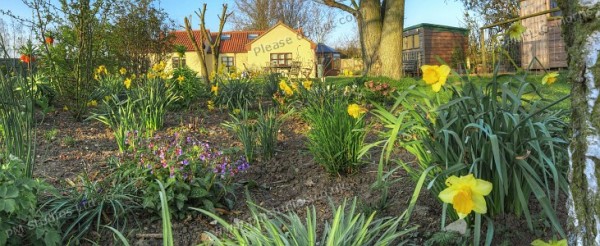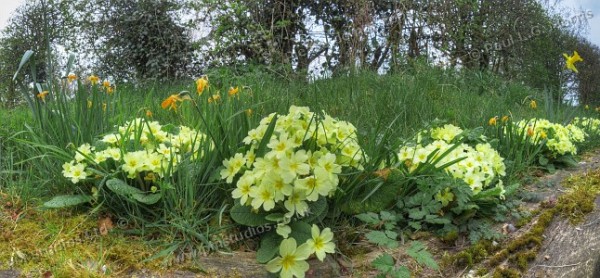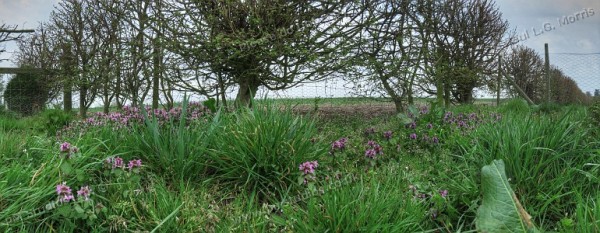I have been experimenting with close-in panoramic views in the garden:
 This panorama was taken in the garden using a compact camera on a home-made ‘panorama head’ with the intention of seeing if such views have potential. I use a compact camera for its small size: this enables me to get the camera in tight spaces.
This panorama was taken in the garden using a compact camera on a home-made ‘panorama head’ with the intention of seeing if such views have potential. I use a compact camera for its small size: this enables me to get the camera in tight spaces.
I made a small panorama head so that the camera rotates about a point that removes parallax errors – quite important at close views. Parallax is less of a problem with distant views. The camera is also held on its side to give a wider angle of view top to bottom although this means that more photos need to be taken to cover the horizontal view.
At these distances, even the slightest of air movement can wobble the flowers and leaves. At the moment, the stillest time of the day is quite early in the morning. Even so I had to take care with my timing. In one of the images used for the above view the daffodils moved but I was able to eliminate this from the panorama as there was sufficient overlap between the adjacent images.
In this view I took photos of primulas adjacent to a hawthorn hedge:
 This image shows the distortion that can be seen in such panoramas – they are planted along a large, long and straight wooden sleeper which distorts and bends dramatically in this view. Again, this was taken early in the morning to minimise wind movement. Even so, there was a daffodil on the left that moved which I cropped out of the final image.
This image shows the distortion that can be seen in such panoramas – they are planted along a large, long and straight wooden sleeper which distorts and bends dramatically in this view. Again, this was taken early in the morning to minimise wind movement. Even so, there was a daffodil on the left that moved which I cropped out of the final image.
But pretty flowers was not all that I photographed:
 This shows weeds and grass growing in an unused chicken run next to a hedge. In this image, depth of field (the amount of the view front to back that is is focus) is a problem. Most of the grass and weeds are in focus as I wanted. but the large dock leaf on the right is closer to the camera so is out of focus.
This shows weeds and grass growing in an unused chicken run next to a hedge. In this image, depth of field (the amount of the view front to back that is is focus) is a problem. Most of the grass and weeds are in focus as I wanted. but the large dock leaf on the right is closer to the camera so is out of focus.
Overall, I found this to be an interesting exercise and showed that the technique has merit.
More of these images can be seen in the testing area of the panorama gallery.
